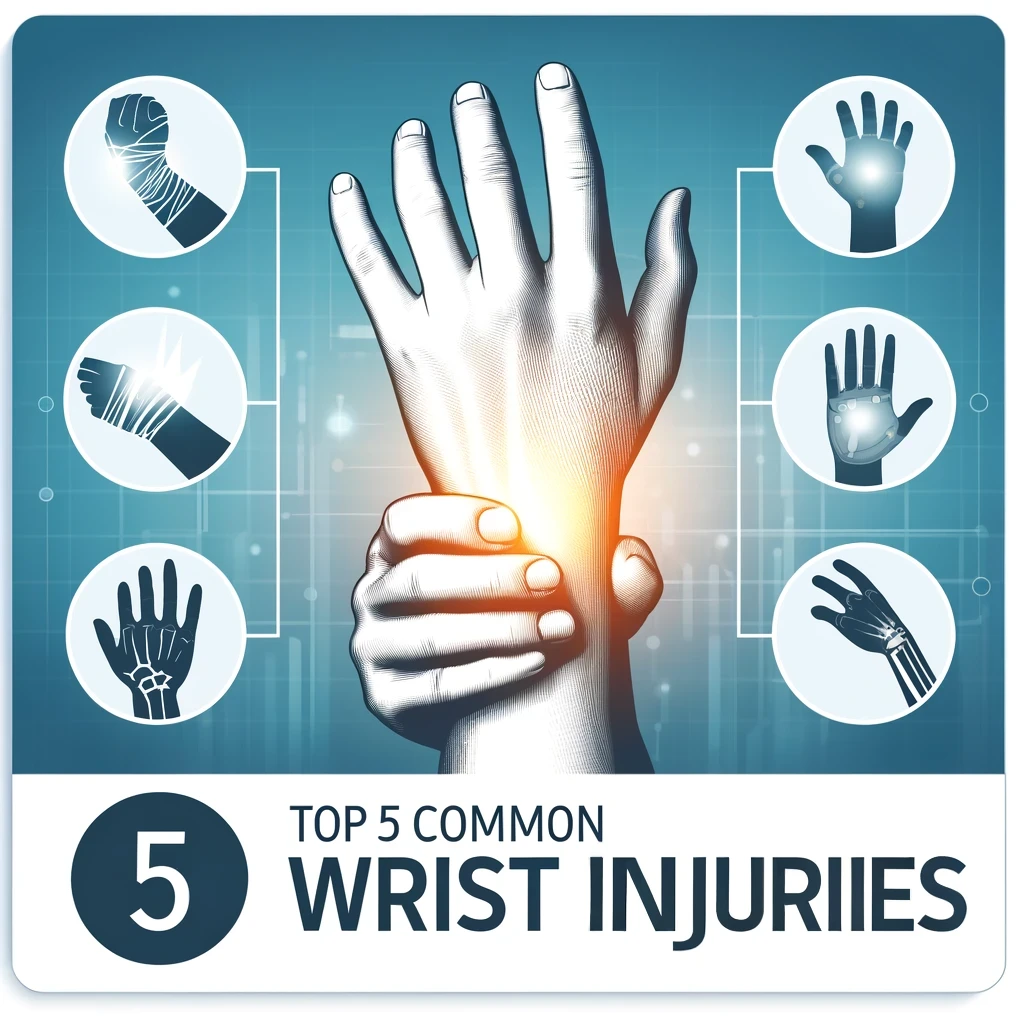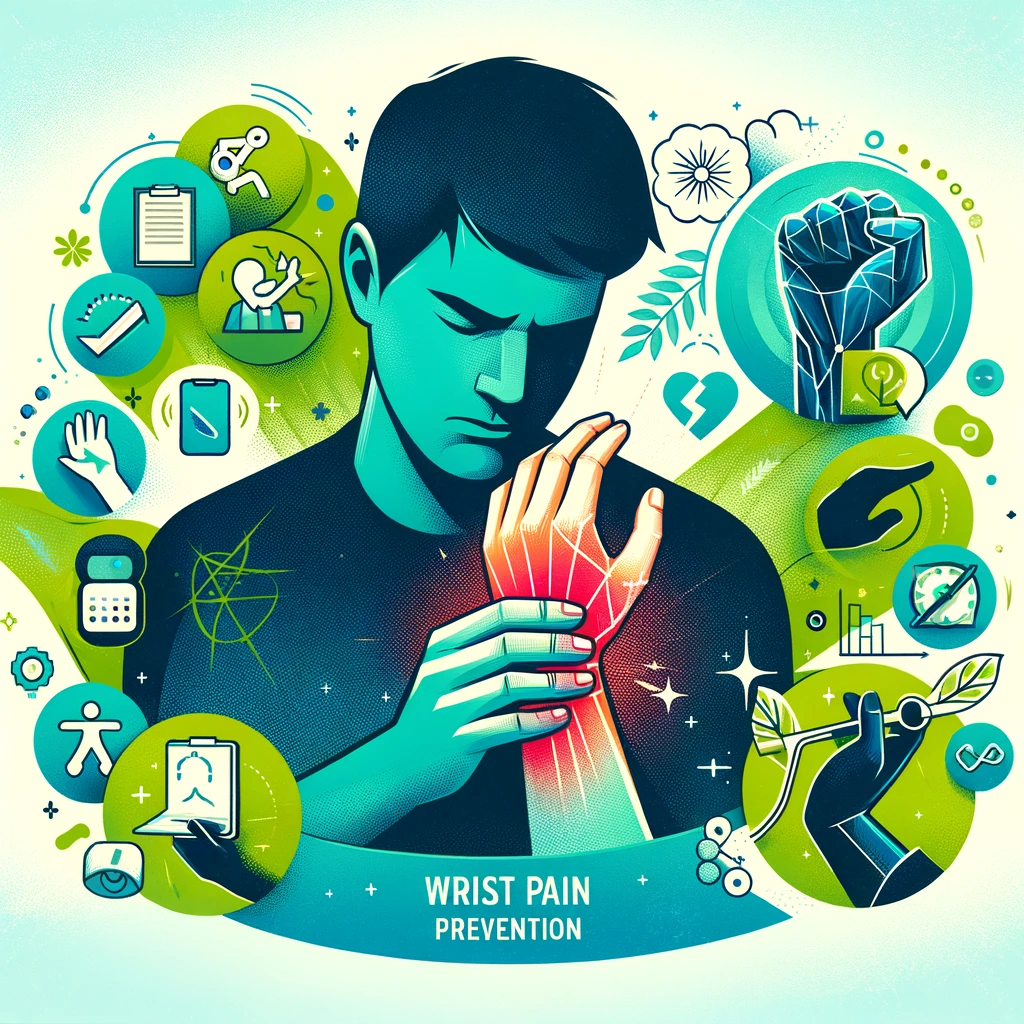
Table of Contents
Wrist health is essential for performing everyday tasks, from typing on a keyboard to lifting objects. However, wrist injuries are common and can significantly impact your daily activities and overall quality of life. This article explores the top five common wrist injuries and provides practical tips on how to prevent them.
Anatomy of the Wrist
Bones of the Wrist
The wrist comprises eight small bones called carpal bones, arranged in two rows. These bones connect the hand to the forearm, allowing a range of movements.
Ligaments and Tendons
Ligaments connect the carpal bones to each other and to the bones in the hand and forearm, providing stability. Tendons attach muscles to bones, enabling movement.
Muscles and Nerves
The muscles controlling wrist movements are located in the forearm. Nerves such as the median nerve pass through the wrist, providing sensation and movement.
Common Causes of Wrist Injuries
Overuse and Repetitive Strain
Repetitive motions, like typing or playing sports, can lead to overuse injuries. These repetitive movements strain the tendons and ligaments in the wrist, causing pain and inflammation.
Trauma and Impact
Falls, direct blows, or accidents can cause wrist injuries, including fractures and sprains. These injuries occur when the wrist is forcefully twisted or bent.
Poor Ergonomics
Using improper techniques or poorly designed tools can place excessive stress on the wrist, leading to injuries over time.
Top 5 Common Wrist Injuries
Carpal Tunnel Syndrome
Carpal tunnel syndrome occurs when the median nerve is compressed as it passes through the carpal tunnel in the wrist. This condition causes numbness, tingling, and weakness in the hand.
Wrist Sprains
Wrist sprains happen when the ligaments in the wrist are stretched or torn, usually due to a fall or sudden twist. Symptoms include pain, swelling and bruising.
Tendonitis
Tendonitis is inflammation of the tendons in the wrist, often caused by repetitive strain or overuse. It results in pain, tenderness, and limited movement.
Wrist Fractures
Wrist fractures are breaks in one or more of the carpal bones or the radius. These fractures usually result from falls or direct impact and cause severe pain, swelling, and deformity.
De Quervain’s Tenosynovitis
De Quervain’s tenosynovitis involves inflammation of the tendons on the thumb side of the wrist, leading to pain and swelling near the base of the thumb.
Carpal Tunnel Syndrome
Symptoms
- Numbness and tingling in the thumb, index, and middle fingers
- Weakness in the hand
- Difficulty performing fine motor tasks
Causes
- Repetitive hand movements
- Wrist anatomy
- Health conditions like diabetes and arthritis
Prevention Tips
- Take regular breaks from repetitive tasks
- Use ergonomic tools and setups
- Perform wrist stretches and exercises
Wrist Sprains
Symptoms
- Pain and tenderness
- Swelling and bruising
- Limited range of motion
Causes
- Falls onto an outstretched hand
- Sudden twists or impacts
Prevention Tips
- Wear wrist guards during high-risk activities
- Strengthen wrist muscles
- Avoid sudden, forceful movements
Tendonitis
Symptoms
- Pain and tenderness along the affected tendon
- Swelling and warmth
- Difficulty moving the wrist
Causes
- Repetitive motions
- Overuse of the wrist
- Inflammatory conditions
Prevention Tips
- Vary repetitive tasks to avoid overuse
- Use proper techniques during activities
- Stretch and strengthen wrist tendons regularly
Wrist Fractures
Symptoms
- Severe pain and swelling
- Visible deformity
- Inability to move the wrist
Causes
- Falls onto an outstretched hand
- Direct blows or impacts
Prevention Tips
- Wear protective gear during sports
- Improve balance to prevent falls
- Strengthen bones through diet and exercise
De Quervain’s Tenosynovitis
Symptoms
- Pain and swelling near the base of the thumb
- Difficulty gripping or pinching
- A catching or snapping sensation
Causes
- Repetitive hand or wrist movements
- Direct injury to the wrist or tendon
- Inflammatory conditions
Prevention Tips
- Avoid repetitive thumb movements
- Take frequent breaks from hand-intensive activities
- Perform exercises to strengthen the thumb and wrist
Preventive Measures for Wrist Injuries
Proper Ergonomics
Setting up an ergonomic workspace can reduce strain on the wrists. Ensure your desk, chair, and keyboard are positioned correctly to support proper wrist alignment.
Strengthening Exercises
Regularly performing exercises that strengthen the wrist muscles can prevent injuries. Exercises like wrist curls, grip strengthening, and resistance band exercises are beneficial.
Stretching Routines
Incorporating wrist stretches into your daily routine can maintain flexibility and reduce the risk of injury. Stretching before and after activities is particularly important.
Protective Gear
Wearing protective gear, such as wrist guards or braces, can provide additional support during high-risk activities like sports or heavy lifting.
Role of Exercise in Wrist Health
Benefits of Regular Exercise
Exercise not only strengthens muscles but also improves flexibility and joint health. Regular physical activity can prevent injuries and promote overall wrist health.
Specific Exercises for Wrist Strength
Exercises like wrist curls, reverse wrist curls, and wrist extensions with light weights or resistance bands can build strength in the wrist muscles.
Flexibility and Mobility Workouts
Flexibility exercises, such as wrist flexor and extensor stretches, can improve the range of motion and prevent stiffness.
Ergonomics and Wrist Health
Importance of Ergonomics
Proper ergonomics reduce the strain on the wrists, preventing injuries caused by repetitive stress or poor posture.
Setting Up an Ergonomic Workspace
Adjust your workspace to ensure that your wrists remain in a neutral position. Use ergonomic keyboards, mouse pads and chairs to support proper posture.
Tools and Accessories
Ergonomic accessories, such as wrist rests, adjustable desks, and ergonomic mice, can help maintain wrist health by reducing strain.
When to Seek Medical Attention
Signs of Serious Injury
Seek medical attention if you experience severe pain, swelling, or deformity in the wrist, or if you are unable to move your wrist or hand.
Diagnostic Procedures
Doctors may use X-rays, MRI, or ultrasound to diagnose wrist injuries accurately. Early diagnosis and treatment are crucial for effective recovery.
Treatment Options
Treatment for wrist injuries may include rest, ice, compression, and elevation (RICE), physical therapy, medications or in severe cases, surgery.
Living with Wrist Injuries
Pain Management Techniques
Pain management techniques, such as hot and cold therapy, over-the-counter pain relievers and acupuncture, can help alleviate wrist pain.
Assistive Devices
Using assistive devices like braces, splints, or ergonomic tools can provide support and reduce strain on the wrist during recovery.
Lifestyle Adjustments
Making lifestyle adjustments, such as modifying activities and incorporating ergonomic practices, can help manage wrist injuries and prevent future problems.
Conclusion
Wrist injuries are common but can often be prevented with proper care and precautions. By understanding the common causes and symptoms, and by incorporating preventive measures such as ergonomic practices, exercises and protective gear, you can maintain healthy wrists and avoid injury. If you do experience a wrist injury, seeking prompt medical attention and following a comprehensive treatment plan is crucial for a successful recovery.
FAQs
How can I prevent wrist injuries at work?
Use ergonomic tools, take regular breaks, and perform wrist exercises to reduce the risk of injuries at work.
What are the early signs of carpal tunnel syndrome?
Early signs include numbness, tingling and weakness in the hand, particularly in the thumb, index and middle fingers.
Are there specific exercises to prevent wrist injuries?
Yes, exercises like wrist curls, reverse wrist curls, and wrist stretches can help strengthen and maintain flexibility in the wrists.
How long does it take to recover from a wrist sprain?
Recovery time for a wrist sprain can vary from a few weeks to several months, depending on the severity of the injury.
Can wrist injuries lead to long-term problems?
If not properly treated, wrist injuries can lead to chronic pain, reduced mobility and long-term joint issues.



